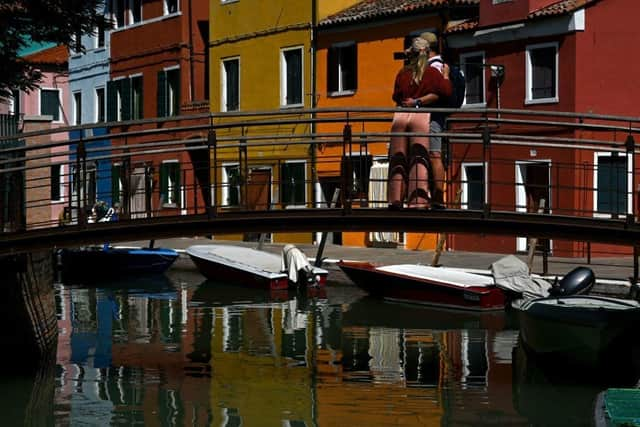Increased politicisation of World Heritage List creating ‘Eurovision style voting’
World Heritage Site selection is being made on geopolitical grounds rather than cultural, creating a “Eurovision style of voting”, a senior Scottish heritage academic has warned.
Dr Ruxandra Stoica, depute director of the Scottish Centre for Conservation Studies and lecturer in architectural conservation at the University of Edinburgh, said the Unesco World Heritage Committee of 21 representatives from 195 signatory countries’ national bodies are increasingly being selected for having “different agendas than just heritage”, leading to sites being inscribed on the World Heritage list for predominantly political reasons.
Advertisement
Hide AdAdvertisement
Hide AdShe said only around 16 per cent of the recommendations for rejection or deferral made to the committee by expert groups had been followed. A total of 16 out of 19 sites, including the Astronomical Observatories of Kazan Federal University in Russia, which were recommended for deferral or rejection by the committee, were nevertheless accepted and included in the 42 new sites added to the World Heritage List this week.


The international World Heritage Committee met earlier this month in Saudia Arabia for 14 days. The number of new additions was higher than usual, taking into account two years’ worth of decisions due to a postponed meeting which had been due to take place in Russia last year, just months after the invasion of Ukraine.
Three independent advisory bodies – the International Union for Conservation of Nature, the International Council on Monuments and Sites and the International Centre for the Study of the Preservation and Restoration of Cultural Property – consider applications from member nations and make recommendations to the World Heritage Committee: whether a site should be inscribed on the list, rejected or deferred.
This year’s representatives on the committee came from Argentina, Belgium, Bulgaria, Egypt, Ethiopia, Greece, India, Italy, Japan, Mali, Mexico, Nigeria, Oman, Qatar, Russian Federation, Rwanda, Saint Vincent and the Grenadines, Saudi Arabia, South Africa, Thailand and Zambia.
"There is an increasing problem between the recommendations of these advisory bodies and the decisions taken by the World Heritage Committee,” said Dr Stoica. “Increasingly, over the past twenty years or so, the World Heritage Committee seems to disregard their advisory bodies and vote politically with other interests. The people who are part of the national committees are not necessarily people who are heritage or conservation professionals, sometimes they are an extension of their government with a completely different agenda.


"A lot of the inscriptions were at odds [with advice] and the previous session, 2020 to 2021, that was the worst ever, there was a concordance factor of just three or four per cent. It is really disappointing and really problematic as the whole point of the procedure, of having advisory bodies made up of professionals is to avoid a Eurovision style of voting.”
She added: "It's increasingly politicised and governments choose to have people on the committee who have different agendas than just heritage. The concordance factor [this year] was very low, so I would see any disagreement with the advisory bodies as a political decision.”
The majority of the newly-designated sites fall under the category of cultural heritage, such as the old town of Kuldiga in Latvia and the prehistoric sites of Talayotic Menorca, Spain. Just nine of the new global sites are natural heritage sites, while 33 are deemed to be cultural.
Advertisement
Hide AdAdvertisement
Hide AdIn addition to the volcanoes and forests of Mount Pelée and the Pitons of Northern Martinique in France, other newly listed natural heritage sites include the evaporitic karst and caves of the Northern Apennines in Italy, the old town of Kuldiga and the Bale Mountains National Park in Ethiopia and the Odzala-Kokoua forest massif in Congo. The ancient fortified city of Ancient Jericho/Tell es-Sultan, located in the West Bank, is also among the sites inscribed by the committee, as is the Gaya Tumuli burial ground in Korea.
One significant recommendation from the expert groups which was not taken up by the committee was to put the Italian city of Venice on the “List of World Heritage in Danger”, mainly due to affects from climate change.
The expert bodies had raised concerns over overtourism, the continued docking of large cruise ships near to the city and that the seawall against rising water levels and floods had not been finalised.
However, the decision was made to leave it off the list.
When Unesco made the announcement, the local authorities rejoiced – pointing to local political opposition support for its inclusion on the list.
“Great victory at UNESCO!!...Venice is not at risk,” the city’s mayor, Luigi Brugnaro wrote on X, the platform formerly known as Twitter. “The world has understood all the work we have done to defend our city, some of the opposition in Venice still hasn't!”
Two Ukrainian sites were inscribed on the in danger list, due to threats linked to shelling. Saint Sophia's Cathedral and complex of monastic and Lavra buildings in Kyiv-Pechersk" and the historic centre of Lviv" join the historic centre of Odesa, which was inscribed on the in-danger list in January 2023 for the same reason.
Unesco said: “The Unesco World Heritage Committee considers that ‘optimal conditions are no longer met to fully guarantee the protection of the Outstanding Universal Value of the property and that it is threatened by potential danger due to the war. Faced with the risk of direct attack, these sites are also vulnerable to the shockwaves caused by the bombing of the two cities.”
Unesco said an addition to the in danger list opens the door to international technical and financial support, as well as signalling the importance of helping to protect these sites to all 195 member states.
Advertisement
Hide AdAdvertisement
Hide AdIn 2021, Liverpool lost its World Heritage status, due to what Unesco described as years of development which had caused “irreversible loss” to the historic value of its Victorian docks.
Dr Stoica is concerned that countries regard removal as less of a stigma in recent years. She pointed to the removal from the list of the Arabian Oryz Sanctuary in Oman in 2007, followed by Dresden Elbe Valley in Germany, two years later.
"Coming off the list was, for a long time, kind of a stick to threaten any country who wasn’t taking care of their heritage – and it seemed to work,” she said. “But once there was a precedent of the Oryx Sanctuary, that seemed to have opened the floodgates. Dresden Elbe Valley was the first time a developed country that had the finances to look after its heritage did not manage to negotiate the protection of the World Heritage Site they already had on the list.
"Any mechanism to hold to account the governments that are signatories of the convention is really a lot about diplomacy and education. You're not going to have economic measures against countries who don’t look after their heritage, so it has to continue to work like that.”
A spokesman for Unesco said: “As an intergovernmental body composed of 21 Member States, representing the 195 States Parties to the Convention, the World Heritage Committee makes sovereign decisions for which we – the Secretariat of the Convention – can’t give comments.
“It should be noted that only a very limited number of files and sites make their way to the Committee – approximately 20 nominations per year, among 195 States Parties – after an extremely rigorous process of at least 18 months. When a file is considered incomplete, the UNESCO Secretariat does not submit to the advisory bodies for evaluation.
“Very often, when the advisory bodies consider that the Outstanding Universal Value of the site is not justified, and that it does not meet the requirements of the Convention, the State Party concerned decides to withdraw it prior to the Committee session, to rework it and submit it at the next session.”
He added: “Furthermore, the legitimate focus on the inscription process should not distract from the real meaning of the World Heritage Convention, which is the protection and monitoring of the sites inscribed: UNESCO continues to closely monitor all these sites to make sure all recommendations adopted by the Committee are duly implemented.”
Comments
Want to join the conversation? Please or to comment on this article.
